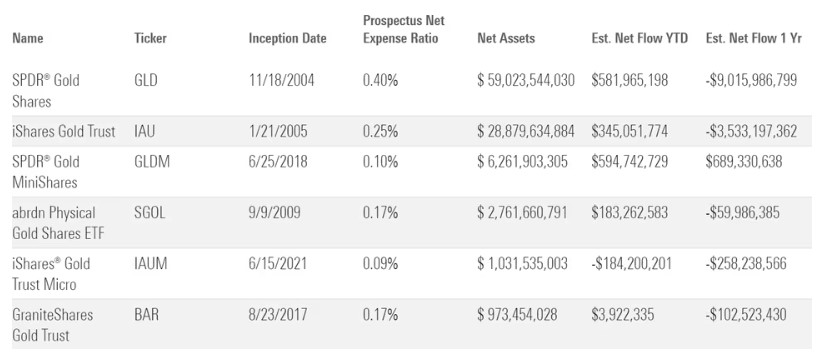Gold has been used as a store of value for thousands of years, serving as a universal medium of exchange and a hedge against economic uncertainty. Unlike paper currency or stocks, gold has intrinsic worth that does not depend on the performance of a company or government. According to the U.S. Department of the Treasury, gold plays a significant role in maintaining economic stability, making it a valuable hedge for investors. For beginners, gold offers a way to preserve wealth during inflationary periods, economic downturns, and market turbulence.
Gold also acts as a diversification tool in an investment portfolio. When other asset classes decline in value, gold often maintains or even increases its worth. This inverse correlation can help stabilize overall portfolio performance, reducing the impact of market volatility. While gold prices can experience short-term fluctuations, history shows that gold consistently holds its value over decades.
The Different Ways You Can Invest in Gold
There is more than one way to add gold to your portfolio. Each option comes with unique advantages and potential drawbacks, so understanding them will help you select the approach that aligns with your financial goals.
Physical Gold – Coins, Bullion, and Bars

Owning physical gold means you hold tangible assets in the form of coins, bullion, or bars. This method provides a sense of security because you have direct control over your investment. However, it also comes with responsibilities, such as arranging secure storage. Investors often choose bank safety deposit boxes, insured vaults, or high-quality home safes. Physical gold also requires careful attention to authenticity, which is why buying from reputable dealers is critical.
Gold ETFs and Mutual Funds
Gold ETFs and mutual funds allow investors to gain exposure to gold without physically storing it. ETFs are traded on stock exchanges, making them easy to buy and sell. Mutual funds can be actively managed, which might appeal to investors seeking professional oversight. These vehicles generally have lower transaction costs and are more liquid than physical gold, making them appealing to beginners.
Gold Mining Stocks
Gold mining stocks offer indirect exposure to gold prices by investing in companies that mine and process gold. These stocks can deliver higher returns if gold prices rise significantly, but they also carry risks tied to the mining industry, including operational costs, regulatory challenges, and geopolitical instability. Mining stocks can be more volatile than physical gold or ETFs.

Digital Gold and Gold-Backed Tokens
Digital gold and gold-backed tokens are emerging investment vehicles that combine technology with tangible value. These products represent ownership of specific quantities of gold stored in secure vaults. Investors can buy and sell them online, often in smaller increments than traditional gold purchases. While convenient, these options require due diligence to ensure the provider is legitimate and transparent.
Current Promotion: get your Free Gold IRA Guide Today!
Investing in Gold Jewelry
Gold jewelry can be both a fashion accessory and a form of gold investment. The gold content and craftsmanship influence its value, and some pieces can appreciate over time. While jewelry often has a higher general cost due to design and labor, it can still serve as a portable and valuable asset that holds intrinsic worth.
Understanding Gold Futures and Options
Gold futures contracts and gold options allow investors to agree on a specific price of gold for a future date. These financial instruments are typically used by sophisticated investors to speculate on price movements or hedge against market conditions. Trading futures and options involves greater volatility and risk, so a clear investment horizon and a strong understanding of the gold market are essential.
The Role of Gold Bullion in a Portfolio
Gold bullion, including bars and coins, represents investment grade gold that many investors view as a reliable alternative asset. Bullion can be bought or sold through major retailers and reputable dealers. Its value is closely tied to gold spot prices, and owning gold bullion provides physical ownership of a tangible and valuable asset that can protect purchasing power in uncertain times.
Exploring Gold-Backed Assets and ETFs
Gold-backed assets, including gold-backed ETFs and gold-backed securities, give investors exposure to actual gold without direct ownership. These vehicles are often considered a valuable asset class for those looking to diversify in the stock market while reducing the need for physical storage. Many investors choose them as an investment option because they provide access to gold holdings in a liquid, tradable form.
Some funds invest exclusively in gold, while others include other precious metals to broaden diversification. The World Gold Council notes that gold maintains a unique role as both a safe haven and a growth asset in uncertain times, making gold exchange traded funds a strategic choice for both beginners and experienced investors.
Selling Gold and Working With Dealers
When it comes time to sell gold, understanding the gold market and your options is essential. Working with reputable gold dealers ensures that you receive a fair market value for your gold product, whether it is gold bars, gold jewelry, or other physical gold assets. Investors who hold gold often compare offers from multiple dealers to secure the best price for a specific amount of gold.
Some may choose to sell gold to fund other assets or rebalance their portfolio. A financial advisor can help you determine the best way to sell based on current market conditions, interest rates, and your long-term investment horizon. Whether you are selling for the first time or managing large amounts of gold holdings, having a clear strategy can maximize returns and protect your wealth.
Curious about how Gold and Silver investing compare? Check out our new guide: How to invest in Gold and Silver!
How to Get Started With Gold Investing
Getting started with gold investing involves more than simply making a purchase. It requires a clear understanding of your objectives, budget, and preferred investment method.
Determine Your Investment Goals
Your goals will dictate the type of gold investment that best suits your needs. Some investors use gold as a hedge against inflation, others as a store of value for wealth preservation, and still others as part of a diversified growth strategy.
Decide on Allocation Percentage
Many financial planners recommend allocating 5% to 10% of a portfolio to gold. The right allocation depends on your risk tolerance, time horizon, and other assets in your portfolio. Conservative investors may prefer a smaller percentage, while those seeking greater protection from volatility might opt for more.

Buy From a Trusted Source
Working with a reputable dealer or financial institution is essential. Look for sellers who provide authentication certificates, transparent pricing, and a strong reputation in the industry. Regulatory bodies and industry associations can also help verify legitimacy.
Current Promotion: $15,000 in Free Silver on Qualified Purchases
Understand Pricing and Premiums
The spot price is the base market price for gold, but buyers usually pay more due to dealer premiums, which cover minting, distribution, and dealer profit. Comparing prices from multiple sources will help ensure you get the best deal possible.
Mistakes to Avoid When Investing in Gold
Investors often make avoidable mistakes that can impact returns. One common pitfall is overpaying for gold due to excessive premiums or purchasing from unreliable sources. Another is neglecting storage security, which can put assets at risk. Liquidity should also be a consideration, as certain gold forms are harder to sell quickly. Finally, investing solely in gold without balancing it with other asset classes can reduce long-term growth potential.
Spotlight on Hamilton Gold Group
Hamilton Gold Group is a well-known name in the precious metals industry, specializing in helping investors purchase and store gold securely. They offer services such as physical gold purchases, gold IRA rollovers, and insured storage options. For beginners, their client-focused approach, transparent pricing, and educational resources can make the process of buying gold straightforward and stress-free. Working with a trusted provider like Hamilton Gold Group can give new investors confidence as they begin their journey into gold investing.

Current Promotion: Unconditional Buy Back Guarantee
Tips for Long-Term Success in Gold Investing
Success with gold investing comes from patience, discipline, and a diversified approach. Monitor market trends and adjust your allocation as needed. Keep storage secure and insured. Combine gold with a mix of stocks, bonds, and other assets to reduce risk while maintaining growth potential. Reviewing your portfolio regularly ensures your gold investments remain aligned with your financial goals.
Conclusion
Gold remains one of the most enduring and trusted forms of investment in the world. For beginners, it offers stability, portfolio diversification, and protection against inflation and market instability. By understanding the different ways to invest, taking steps to avoid common mistakes, and working with reputable sources, you can build a gold investment strategy that aligns with your long-term financial goals. Whether you choose physical gold, ETFs, mining stocks, or digital options, a disciplined and informed approach will help you make the most of your investment.
FAQs
Most financial experts suggest between 5% and 10% of your portfolio, depending on your goals and risk tolerance.
Gold often maintains or gains value during recessions, making it a common safe-haven asset.
Physical gold offers tangible ownership, while ETFs provide convenience and liquidity. Your choice depends on personal preferences and storage capabilities.
Consider secure home safes, bank safety deposit boxes, or insured third-party vaults.
Yes, certain self-directed IRAs allow physical gold investments if they meet IRS regulations.
Top U.S. Brokers of 2025

★ ★ ★ ★ ★
✅ Now 23 million users
✅ Cash mgt account and credit card
Free stock up to $200 with new account, plus up to $1,500 more in free stock from referrals
Get Free Stock
★ ★ ★ ★ ★
✅ Access to U.S. and Hong Kong markets
✅ Educational tools
Deposit $100, get $20 in NVDA stock; Deposit $2,000, get $50 in NVDA stock; Deposit $10,000, get $300 in NVDA stock; Deposit $50,000, get $1,000 in NVDA stock
Get Free Shares
★ ★ ★ ★ ☆
✅ IBKR Lite & Pro tiers for all
✅ SmartRouting™ and deep analytics









